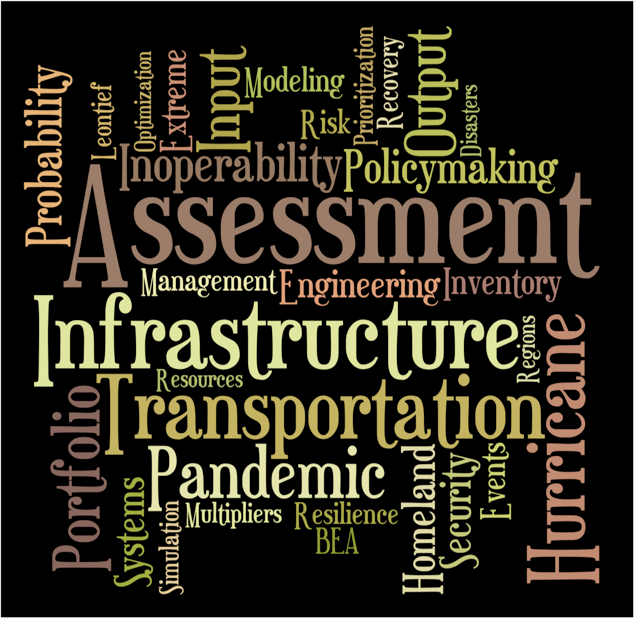RESEARCH

grants
NOTE: The following list only includes grants that I acquired since I started my GWU appointment in 2009. For pre-GWU research projects, please refer to my CV here.
TITLE: Collaborative Research: Flexible Multi-Scale Models of Transportation Network Service Recovery
SOURCE: National Science Foundation
AMOUNT: $215,942
PERIOD: 05/01/14 - 04/30/17
TITLE: Year-Round Provision of Access to Safe Water in Northern Samar, Philippines
SOURCE: University of Waterloo (Funding Agency: Grand Challenges Canada)
AMOUNT: $18,210
PERIOD: 07/01/14 - 09/30/15
TITLE: Coordinated Risk Analysis of Coupled Workforce-Infrastructure Systems
AMOUNT: $10,000
PERIOD: Academic Year 2014-2015
TITLE: Enhancing Communities' Capability to Evaluate Investments in Resilience
SOURCE: American Society of Mechanical Engineers (ASME) Innovative Technologies Institute, LLC
AMOUNT: $45,850
PERIOD: 01/01/11 - 12/31/11
TITLE: Collaborative Disaster Policymaking across Critical Infrastructure and Key Resource (CI/KR) Sectors
SOURCE: George Washington Institute of Public Policy
AMOUNT: $10,000
PERIOD: Academic Year 2011-2012
TITLE: Decision Support System for Integrating Epidemic Surveillance, Regional Interdependencies and Strategic Preparedness (with Larissa May, GWU Medicine)
SOURCE: George Washington University Institute for Biomedical Engineering
AMOUNT: $9,952
PERIOD: Academic Year 2011-2012
TITLE: Collaborative Research: Modeling the Efficacy of Inventory for Extreme Event Preparedness Decision Making in Interdependent Systems
SOURCE: National Science Foundation
AMOUNT: $153,006
PERIOD: 09/01/09 - 08/31/13
areas of interest
I believe that a researcher must be flexible and adaptive to the evolving problems, trends, and needs of the present society and the interdependent global economy. With the advent and accelerated pace of modern technologies, people and systems across our 'flat world' (a concept popularized by Thomas Friedman) are becoming more and more interdependent. Systems engineering textbooks typically define 'system' as a collection of interconnected elements working for a common goal. My systems engineering background has provided me a more holistic outlook and appreciation of the inherent interconnections that need to be recognized in order to continuously deliver and improve the as-planned performance of large-scale systems. In particular, I have dedicated years of research efforts towards understanding, modeling, and managing the interdependencies across various infrastructure and economic systems.
Critical infrastructure systems (e.g., oil and gas pipelines, transportation, telecommunications, electric power, banking, etc.) are highly complex and interdependent. These interdependencies take the form of physical connections, information flows, organizational partnerships, and exchanges of commodities and services, among others. Our modern world has become more reliant on the essential services these critical infrastructure systems provide; hence ensuring their availability and recovery is of paramount importance particularly in the aftermath of disasters. Failure of infrastructure systems can also spin off additional public safety and environmental concerns, as proven by disastrous events such as the I-35 bridge collapse, Gulf Coast oil spill, nuclear reactor breach, and many others. In his seminal book (Normal Accidents), Charles Perrow coined the term 'interactive complexity' to describe chaotic outcomes that can potentially stem from a combination of two or more 'normal' discrete failures.
The urgent need for in-depth modeling, assessment, and management of natural and man-made disasters has increasingly become more pervasive and has gained worldwide recognition in recent years. A case in point, the 9.0-magnitude earthquake in Japan literally created severe ripple effects, which notably include the destructive tsunami that swiped the northeastern coastal regions, threat of nuclear reactor failures, and significant production losses that cascaded to the global economy. Other prominent disasters in recent years (like the Haiti earthquake, 9-11 terrorist attacks, hurricane Katrina, China earthquake, Myanmar cyclone, Indian Ocean tsunami, Typhoon Haiyan, disease pandemics, and many others) have resulted in massive loss of lives, disruptions to economic livelihoods, and irreversible damage to critical infrastructure systems.
Risk analysis of catastrophic events spans interdisciplinary fields including natural sciences, social sciences, applied sciences, and engineering. An effective research program ought to be cognizant of the prevailing and constantly-evolving problems and needs of the modern society. This requires collaborative and synergistic contributions from interdisciplinary teams, taking into account the importance of validation, verification, and seamless integration of theory with real-world applications. I am fortunate to have served as an investigator and collaborator to a variety of research projects, where opportunities exist to apply my specialization (in systems engineering and risk analysis) to interdisciplinary applications with broad societal impacts. In my involvement with various research projects, I have published over 40 papers that demonstrate not only my collaborative research experience but also my personal research pursuits.







